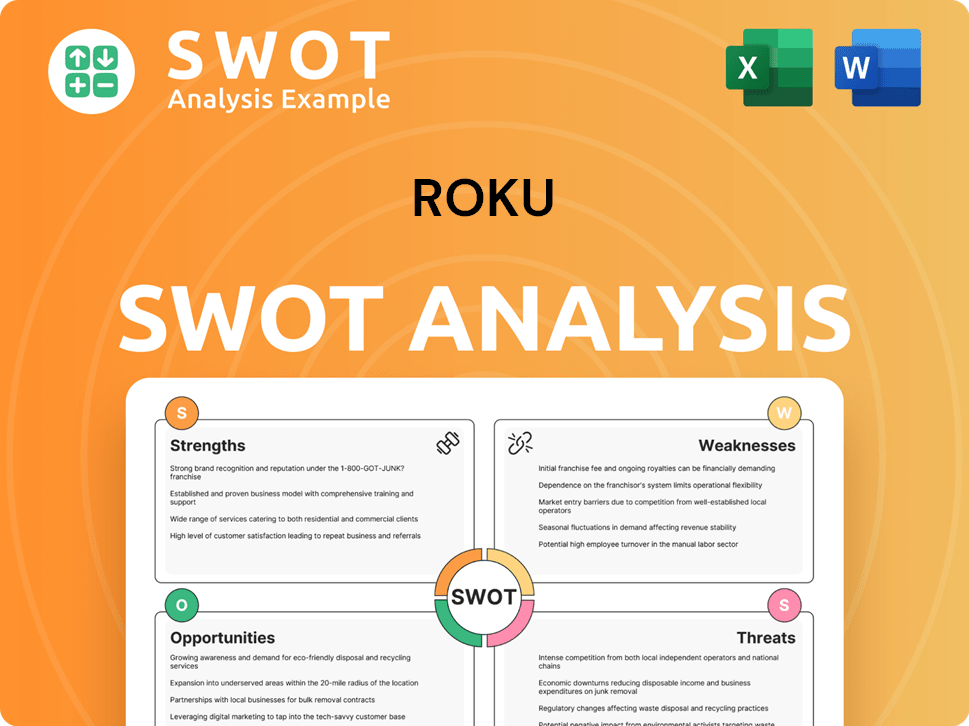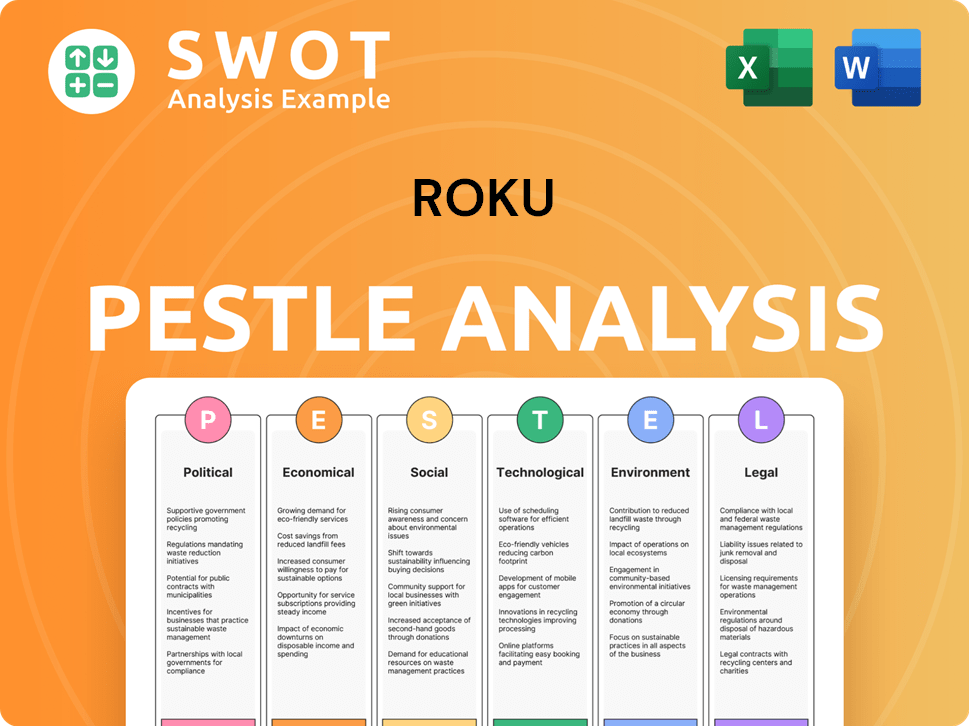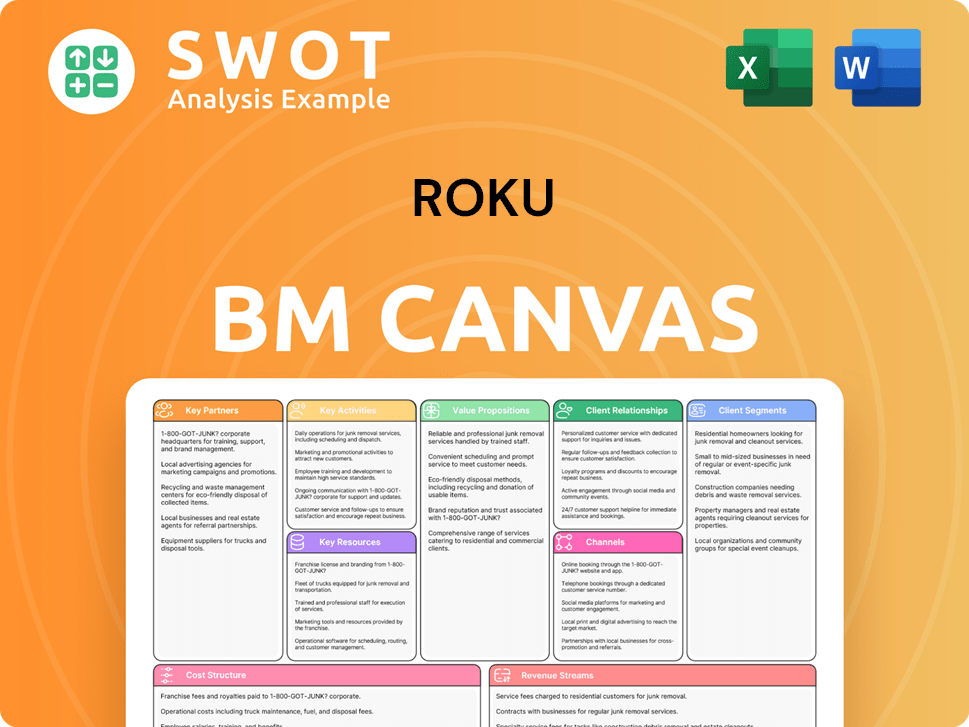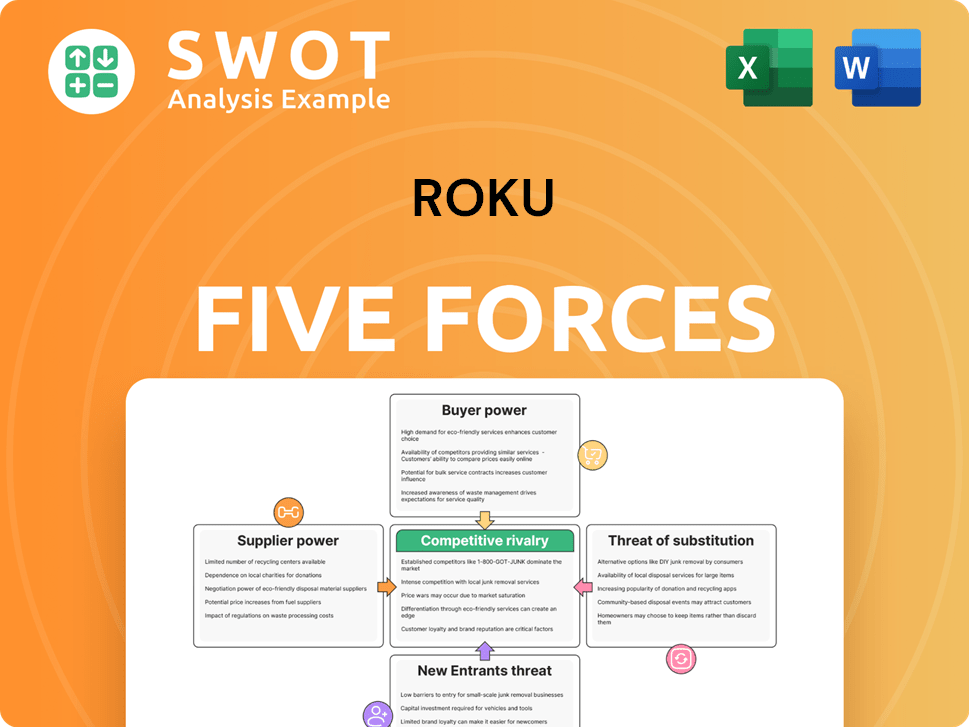Roku Bundle
Decoding Roku: What Drives Its Success?
Understanding a company's core principles is key to grasping its trajectory. Roku, a leader in the streaming world, hinges its strategy on a clear mission, vision, and set of core values. These elements shape its approach to the competitive streaming landscape.

This exploration delves into the Roku SWOT Analysis and the fundamental pillars that guide the Roku company. Discover how Roku's mission, vision, and core values contribute to its success within the dynamic Roku streaming industry. Learn how these principles impact Roku's culture and shape its long-term goals.
Key Takeaways
- Roku's mission, vision, and values are fundamental to its success in streaming.
- The mission focuses on connecting the TV ecosystem, while the vision aims to revolutionize content consumption.
- Core values like innovation and customer focus guide Roku's strategic decisions and operations.
- Alignment with these principles is crucial for Roku's future growth and market leadership.
- Roku's financial performance reflects the positive impact of staying true to its core principles.
Mission: What is Roku Mission Statement?
Roku's mission is 'to be the streaming platform that connects and benefits the entire TV ecosystem around the world.'
Let's delve into the core of Roku's operational philosophy and its strategic direction. The Roku mission statement is not just a corporate tagline; it's a comprehensive declaration of intent that shapes the company's actions and its place in the rapidly evolving streaming landscape. Understanding this mission is crucial for anyone looking to assess Roku's current standing and its future potential. This is particularly relevant for investors, analysts, and anyone interested in the dynamics of the entertainment and technology sectors.
The mission highlights Roku's role as a central hub. It aims to connect users, content publishers, and advertisers. This is achieved through its platform, which aggregates various streaming services.
Roku's mission has a global scope, aspiring to power every TV worldwide. This ambition drives expansion into new markets and partnerships. This global approach is key to its long-term growth strategy.
Roku focuses on providing easy access to a wide array of streaming services. It also delivers innovative technology to enhance the user experience. This includes continuous updates to its operating system (Roku OS).
The mission is strongly customer-centric, aiming to empower users. It is also innovation-focused, emphasizing cutting-edge technology and continuous improvement. This is reflected in the user-friendly design of its devices and platform.
The Roku Channel exemplifies the mission by offering a wide variety of content, including free, ad-supported options. This commitment to accessible entertainment is a key component of its mission.
Roku's mission is reflected in its business operations, including its focus on developing user-friendly streaming devices and its operating system (Roku OS), which is updated across its global installed base. The company continuously strives to improve its products and services.
This mission statement provides a clear framework for understanding Roku's vision and strategic direction. It emphasizes the company's commitment to connecting the various components of the television ecosystem. As of Q1 2024, Roku had 81.6 million active accounts, demonstrating its significant reach and influence in the streaming market. The company's focus on user experience, content aggregation, and global expansion aligns directly with its mission. The Roku company continues to innovate, with recent developments including enhancements to its advertising platform and the expansion of its content offerings. For a deeper dive into how Roku generates revenue, consider exploring the Revenue Streams & Business Model of Roku.
Roku SWOT Analysis
- Complete SWOT Breakdown
- Fully Customizable
- Editable in Excel & Word
- Professional Formatting
- Investor-Ready Format

Vision: What is Roku Vision Statement?
Roku's vision is 'to revolutionize how people consume content by providing a seamless and personalized streaming experience.'
Let's delve into the Roku vision and what it means for the company's future. Understanding the Roku vision is crucial for grasping its strategic direction and long-term goals. This vision statement encapsulates Roku's ambition to transform the entertainment landscape, making streaming the primary way people access and enjoy content globally.
The Roku vision is future-oriented, focusing on how people will interact with content. It's about more than just providing access; it's about creating a personalized, effortless, and integrated streaming experience that becomes central to daily life.
Roku aims to seamlessly integrate streaming into every aspect of daily life. This involves providing personalized recommendations, easy navigation, and a unified platform for all streaming services, enhancing user satisfaction.
The ultimate goal of the Roku vision is to become the leading platform for streaming services. This means not just offering a wide variety of content, but also providing the best user experience, attracting both viewers and content providers.
Given Roku's current market position, the vision is both realistic and aspirational. Roku is a leading TV streaming platform in the U.S., Canada, and Mexico, with over 90 million active accounts as of early 2025, demonstrating its potential for further growth.
Roku's commitment to innovation, expanding content options, and enhancing user experience supports its ambition. The company continually introduces new features and partnerships to improve its platform and stay ahead of the competition.
Roku's vision has a significant impact on the streaming industry, driving innovation and shaping how consumers access content. The company's focus on user experience and platform development positions it for continued growth and success.
The Roku vision is a driving force behind its strategic decisions. The company's commitment to this vision is evident in its product development, partnerships, and overall business strategy. To understand how Roku stacks up against its rivals, consider looking at the Competitors Landscape of Roku.
Roku PESTLE Analysis
- Covers All 6 PESTLE Categories
- No Research Needed – Save Hours of Work
- Built by Experts, Trusted by Consultants
- Instant Download, Ready to Use
- 100% Editable, Fully Customizable

Values: What is Roku Core Values Statement?
Understanding the core values of a company provides crucial insights into its operational philosophy and strategic direction. Roku, a leading player in the streaming industry, has established a set of core values that guide its actions and shape its corporate culture.
Innovation is a cornerstone of Roku's approach, driving the continuous development of new products and services to enhance the streaming experience. This commitment is evident in their ongoing efforts to introduce new features, improve existing ones, and expand into new areas like smart home devices. Roku's dedication to innovation is a key factor in its ability to stay ahead in the competitive streaming market, with the company consistently updating its operating system and introducing new streaming devices. For instance, in Q1 2024, Roku's platform revenue grew by 19% year-over-year, demonstrating the impact of its innovative offerings and user engagement. This growth is a testament to Roku's commitment to providing a seamless and evolving streaming experience for its users.
Roku places a high priority on customer satisfaction by offering a range of devices at different price points, making streaming accessible to a broad audience. The company's user-friendly interface and personalized recommendations are designed to provide a seamless and enjoyable streaming experience. Roku's focus on the customer is reflected in its high customer satisfaction ratings and its efforts to continuously improve its platform based on user feedback. In 2023, Roku's active accounts reached 80 million, highlighting the company's success in attracting and retaining customers through its customer-centric approach. Their approach to customer satisfaction is a key driver of their success in the streaming industry.
Collaboration is essential for Roku's success, fostering partnerships with content providers, TV manufacturers, and advertisers. These collaborations expand Roku's content library, reach a wider audience, and create value across the entire TV ecosystem. Roku's ability to build and maintain strong partnerships is a key factor in its growth and market position. For example, Roku's partnerships with major streaming services and TV manufacturers have significantly expanded its content offerings and market reach, contributing to its strong performance in the streaming industry. These partnerships are a critical component of Roku's strategy, enabling it to offer a comprehensive and user-friendly streaming experience.
Integrity underpins Roku's ethical business practices, building trust with stakeholders and ensuring the company operates with transparency and accountability. Inclusivity reflects Roku's commitment to fostering a diverse and welcoming corporate culture, ensuring its platform is accessible to a broad range of users. Roku's dedication to these values is reflected in its company culture and its efforts to create a platform that is welcoming to all users. The company's commitment to inclusivity is also demonstrated through its Employee Resource Groups (ERGs), which play a vital role in building an inclusive environment. Understanding the Owners & Shareholders of Roku is also crucial in evaluating the company's commitment to these values.
These core values shape Roku's approach to the streaming ecosystem, emphasizing innovation and user experience while fostering collaboration and maintaining integrity and inclusivity. These principles guide the company's decision-making processes and contribute to its long-term success. Next, we will explore how Roku's mission and vision influence its strategic decisions.
How Mission & Vision Influence Roku Business?
Roku's Roku mission and Roku vision are the cornerstones of its strategic direction, profoundly influencing every aspect of its operations. These guiding principles shape the company's approach to product development, partnerships, and market expansion, ensuring a cohesive and focused strategy.
Roku's commitment to its mission and vision is evident in its strategic choices. The focus on the Roku mission to connect the entire TV ecosystem drives its dual approach to hardware and platform development. The Roku vision of revolutionizing content consumption through a seamless experience guides product innovation and user interface design.
- Continuous innovation of the Roku OS to enhance user experience and content discovery.
- Strategic partnerships with TV manufacturers to license the Roku OS, expanding reach.
- Development and promotion of The Roku Channel, offering diverse content options.
- Deepening programmatic advertising relationships and data monetization efforts.
Roku's strategy is a direct result of its mission to connect the entire TV ecosystem. This is achieved through the sale of streaming devices and, increasingly, through the licensing of its operating system to TV manufacturers. This dual approach allows Roku to capture value from both hardware sales and platform services, like advertising and content distribution. The Roku company has successfully leveraged this synergy to grow its user base and revenue streams.
The Roku vision of a seamless and personalized content experience is central to its product development. The Roku OS is constantly updated to improve content discovery, provide a user-friendly interface, and offer personalized recommendations. This customer-centric approach is key to driving user engagement and loyalty, critical for long-term success in the competitive Roku streaming market.
Roku's partnerships with TV manufacturers and content providers are crucial to its growth strategy. Licensing the Roku OS to TV manufacturers expands its reach and user base, aligning with its mission to be on every TV. Collaborations with content providers ensure a wide variety of entertainment options, supporting its vision of a comprehensive streaming experience. These partnerships are essential for Roku to maintain its market leadership and achieve its long-term goals.
Roku's platform-centric strategy includes a significant focus on advertising and data monetization. The company leverages its user data to provide targeted advertising, benefiting both content publishers and advertisers within its ecosystem. This approach drives platform revenue growth, which was 18% year-over-year in 2024, and is projected to grow by 12% in 2025. This aligns with the Roku core values of innovation and creating value for all stakeholders.
Roku's success is reflected in its key performance indicators. Streaming households surpassed 90 million in early 2025, demonstrating the effectiveness of its mission-driven strategy. Its leadership in the U.S. connected TV market, with a significant market share, further indicates the impact of its mission and vision. These metrics are a testament to the company's commitment to its guiding principles.
Roku's leadership consistently reinforces the importance of its mission and vision. CEO Anthony Wood's statement, 'Our focus at Roku is where it's been since day one: redefining what streaming can be,' and President Mustafa Ozgen's emphasis on delivering better TV for everyone, highlight the company's unwavering commitment to its core principles. This consistent messaging helps shape the Roku culture and guide strategic decision-making.
The Roku mission, vision, and Roku core values are not just statements; they are the driving forces behind Roku's strategic decisions, market positioning, and overall success. Understanding these principles is crucial for grasping the company's long-term goals and its impact on the streaming industry. To learn more about the origins and evolution of the company, read our Brief History of Roku. Next, we will delve into the core improvements to the company's mission and vision.
Roku Business Model Canvas
- Complete 9-Block Business Model Canvas
- Effortlessly Communicate Your Business Strategy
- Investor-Ready BMC Format
- 100% Editable and Customizable
- Clear and Structured Layout

What Are Mission & Vision Improvements?
While Roku's current mission, vision, and core values have propelled its success in the streaming industry, there's always room for enhancement to ensure sustained growth and relevance. This section explores potential improvements, focusing on sustainability, technological adaptation, and further strengthening of its core principles.
To align with evolving consumer and investor expectations, Roku could explicitly incorporate sustainability into its core values and vision. This could involve adding a phrase to the vision statement recognizing the importance of a responsible streaming ecosystem and explicitly including "Sustainability" as a core value. This would underscore Roku's commitment to its net-zero carbon emissions goal by 2050 and could attract environmentally conscious consumers. As of Q1 2024, the global streaming market is valued at $81.7 billion, with sustainability becoming a key differentiator.
Roku's mission and vision should adapt to the rapid evolution of technology and content consumption. This includes incorporating statements that address immersive content formats, interactive experiences, and personalized content discovery, ensuring long-term relevance in a dynamic industry. The rise of immersive content formats like virtual reality (VR) and augmented reality (AR) presents new opportunities for the Growth Strategy of Roku, which can be integrated into its vision.
While Roku's mission emphasizes providing access to streaming content, explicitly highlighting customer satisfaction and user experience within its core values would be beneficial. This could involve adding a value focused on "Customer Delight" or "User-First Approach," emphasizing continuous improvement based on user feedback and personalized experiences. Roku's current user base is over 80 million active accounts, which could be further enhanced by prioritizing customer satisfaction.
Roku’s mission and vision could benefit from a stronger emphasis on innovation and agility to navigate the competitive streaming landscape. This could involve incorporating phrases that highlight a commitment to continuous improvement, experimentation, and embracing new technologies. This would ensure that the Roku company remains at the forefront of the industry, adapting to shifts in consumer behavior and technological advancements. The streaming industry is expected to reach $100 billion by 2027, making innovation and agility crucial for sustained growth.
How Does Roku Implement Corporate Strategy?
Implementing a company's mission, vision, and core values is crucial for translating strategic intent into tangible actions and outcomes. This section examines how the Roku company brings its guiding principles to life through its business practices and organizational culture.
Roku actively demonstrates its Roku mission and Roku vision through continuous product development and strategic partnerships. These actions directly support its goals of providing a seamless streaming experience and connecting users with the content they love.
- Roku OS Updates: Regular updates to the Roku OS, including personalized recommendations and enhanced content discovery, directly embody the vision of a user-friendly and personalized streaming experience. In Q1 2024, Roku added over 1,000 new channels to its platform, showcasing its commitment to content discovery.
- The Roku Channel Expansion: The growth of The Roku Channel, with its increasing content library and partnerships, reflects the mission of connecting users with content and benefiting content publishers. The Roku Channel saw a 20% increase in streaming hours year-over-year in Q1 2024.
- Content Partnerships: Roku's collaborations with content providers and TV manufacturers are key to its mission. These partnerships ensure a wide variety of content and easy access for users. Roku has partnerships with over 10,000 content partners as of 2024.
- Affordable Devices: Roku's commitment to offering affordable streaming devices is a concrete example of its customer-focused approach. Roku's streaming players start at $29.99, making streaming accessible to a broad audience.
Leadership plays a vital role in communicating and reinforcing the company's mission, vision, and values. CEO Anthony Wood and other key leaders consistently articulate the company's focus on the streamer's journey and delivering better TV for everyone.
This messaging is disseminated through investor calls, press releases, and the company website, ensuring consistent communication with stakeholders. For instance, in the Q1 2024 earnings call, Anthony Wood emphasized Roku's focus on user engagement and platform growth.
While specific formal programs for values reinforcement are not extensively detailed in public information, several aspects of Roku's operations demonstrate its commitment to its stated principles. These actions are critical for understanding Roku company values examples.
The development of affordable streaming devices, for example, demonstrates a customer-centric approach. Furthermore, the numerous partnerships with TV manufacturers and content providers exemplify a commitment to collaboration. The company's use of stock-based compensation also aligns with a culture that rewards contributions to company success.
Roku's Roku culture is characterized by a fast-paced, collaborative environment with high expectations, implicitly encouraging its values through daily interactions and performance standards. The emphasis on innovation and customer satisfaction further reinforces these values.
This culture is essential for achieving its Roku's long-term goals and vision. The company's success is heavily influenced by its ability to adapt to the rapidly evolving streaming landscape, which is also explored in detail in the Marketing Strategy of Roku.
Roku's success in implementing its mission and vision can be evaluated through key performance indicators (KPIs) such as user engagement, revenue growth, and market share. These metrics provide insights into the effectiveness of its strategies.
The company's focus on platform revenue and average revenue per user (ARPU) indicates its efforts to monetize its platform and enhance the user experience. Roku's ARPU increased to $46.49 in Q1 2024, demonstrating its success in this area.
Roku Porter's Five Forces Analysis
- Covers All 5 Competitive Forces in Detail
- Structured for Consultants, Students, and Founders
- 100% Editable in Microsoft Word & Excel
- Instant Digital Download – Use Immediately
- Compatible with Mac & PC – Fully Unlocked

Related Blogs
- What are Mission Vision & Core Values of Roku Company?
- What is Competitive Landscape of Roku Company?
- What is Growth Strategy and Future Prospects of Roku Company?
- How Does Roku Company Work?
- What is Sales and Marketing Strategy of Roku Company?
- Who Owns Roku Company?
- What is Customer Demographics and Target Market of Roku Company?
Disclaimer
All information, articles, and product details provided on this website are for general informational and educational purposes only. We do not claim any ownership over, nor do we intend to infringe upon, any trademarks, copyrights, logos, brand names, or other intellectual property mentioned or depicted on this site. Such intellectual property remains the property of its respective owners, and any references here are made solely for identification or informational purposes, without implying any affiliation, endorsement, or partnership.
We make no representations or warranties, express or implied, regarding the accuracy, completeness, or suitability of any content or products presented. Nothing on this website should be construed as legal, tax, investment, financial, medical, or other professional advice. In addition, no part of this site—including articles or product references—constitutes a solicitation, recommendation, endorsement, advertisement, or offer to buy or sell any securities, franchises, or other financial instruments, particularly in jurisdictions where such activity would be unlawful.
All content is of a general nature and may not address the specific circumstances of any individual or entity. It is not a substitute for professional advice or services. Any actions you take based on the information provided here are strictly at your own risk. You accept full responsibility for any decisions or outcomes arising from your use of this website and agree to release us from any liability in connection with your use of, or reliance upon, the content or products found herein.